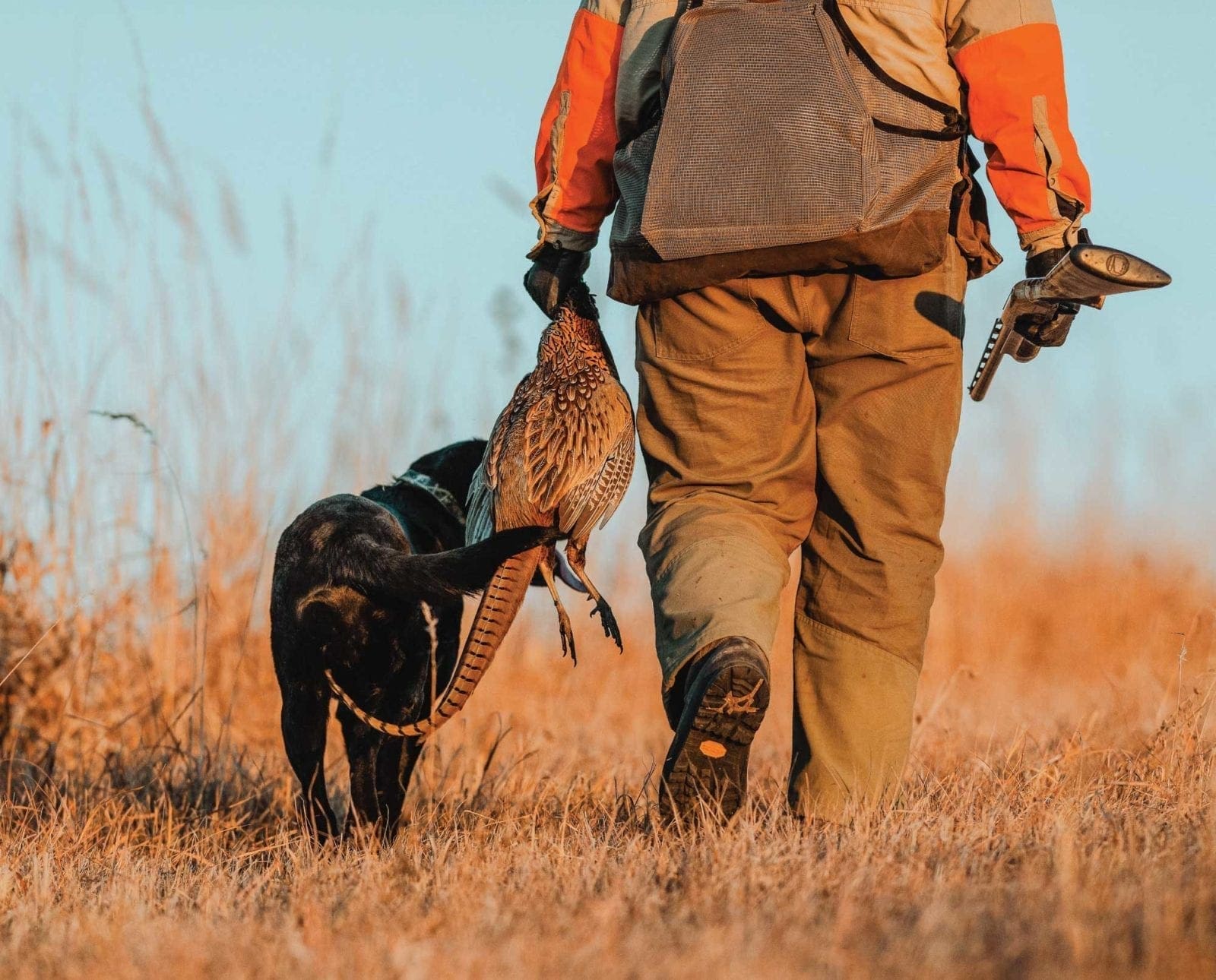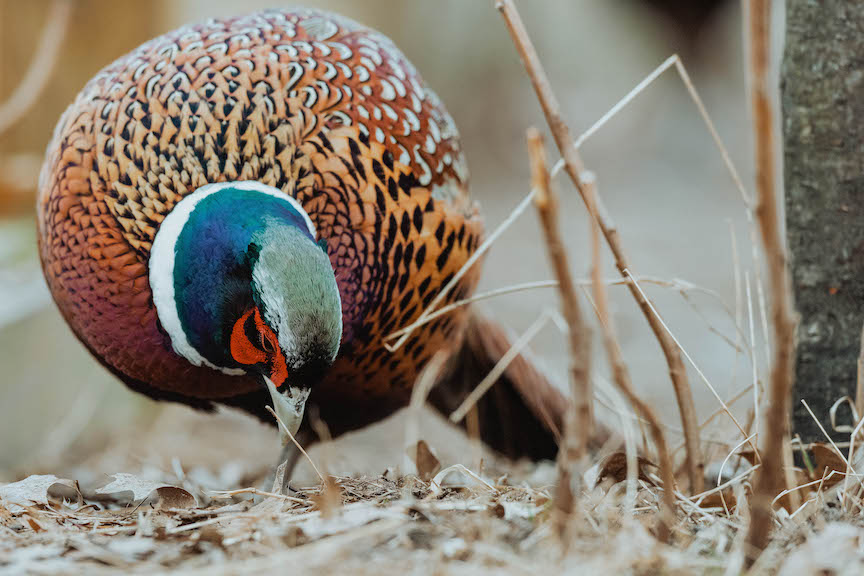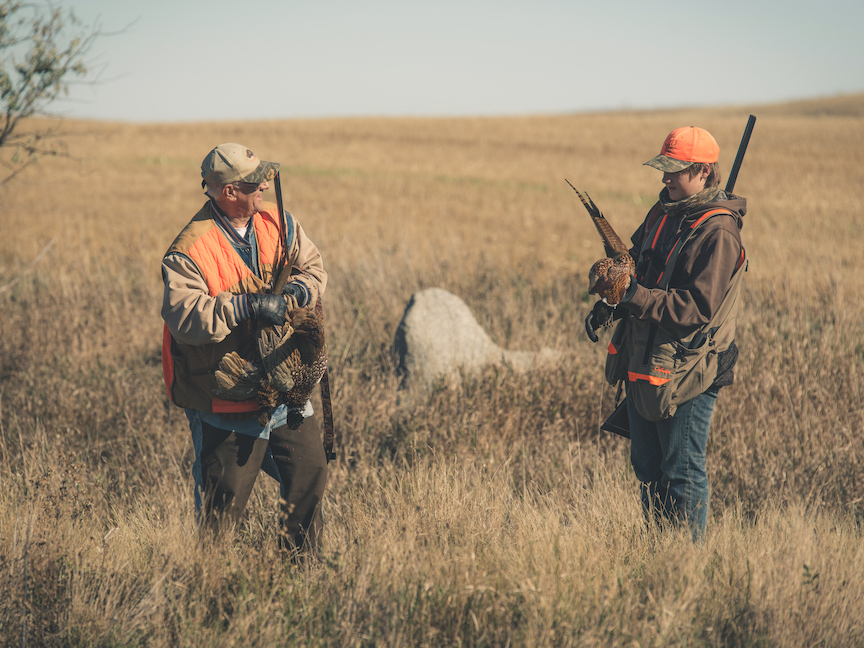Home » Pheasant Hunting » A Guide to Wild Pheasant Hunting in North America
A Guide to Wild Pheasant Hunting in North America

Edgar Castillo is a recently retired law enforcement officer for…
Learn how to hunt pheasants by understanding the gear, identifying the right habitat, and learning about pheasant behavior
The ring-necked pheasant is known for its elusive tactics against hunters and dogs. I refer to it as the court jester of the uplands. The rooster’s mastery of tricks such as holding tight, flushing out of gun range, running, doubling back, and sometimes sneaking right past you is all part of his game. Successful pheasant hunting requires lots of preparation: acquiring knowledge, gaining experience, and scouting. Because a pheasant’s behavior changes so much over the course of the season, it pays dividends for hunters to tailor their tactics accordingly. Early season birds quickly become educated in a matter of hours on opening day. This guide covers what it takes to successfully hunt pheasants and hopefully bag a rooster.
Get educated to outsmart the pheasants
An educated rooster pheasant begins schooling from day one. There is no formal instruction besides learning to do what you gotta do to not get eaten! In pheasant language that translates into run, hide, double-back, cower, and fly. Shouldn’t pheasant hunters put the same effort into their education?
Today’s hunters have the ability to learn how to hunt pheasants through a variety of resources: mentors, field experience, reading, and online research. Ringneck chasers can sit comfortably while they peruse the internet for the latest tactics on how to hunt wily roosters, then go out and apply it in the field. Of course, sometimes this approach assumes that pheasants will play by the rules, but unfortunately, there are no rules for them. The best approach for the hunter is to get out there and learn from mistakes, learn how to identify habitat, and figure out how to hunt certain landscapes. Above all, hunters must learn to be sneaky like pheasants.
Wild Game Recipes: All-American Upland Burger
Choosing gear for pheasant hunting
We all love gear, though some more than others. Selecting the right gear for pheasant hunting can be as simple or complicated as you wish to make it. Essential items include a shotgun, a bird vest (preferably with some blaze orange), a good pair of well-fitted and comfortable boots, upland hunting brush pants for protection, and gloves. For some, the essential gear will include a canine companion and basic items to meet their needs in the field, too.
The ideal shotgun and chokes for pheasant hunting
Choosing a shotgun does not need to be a complex ordeal. Choose a shotgun that works for you. You will hear that the 12 and 20 gauges are the most popular shotguns to use for pheasant hunting, but don’t forget the ever-versatile 16-gauge shotgun to bring down a flushing rooster with the proper load and choke. Not to exclude those purists that shoot the 28-gauge and .410—yes, they can be an effective gun under the right conditions and paired with loads heavy enough to knock down longtails, but those hunters and conditions are few and far between.
The shotgun action can be pump, autoloader, over-under, side-by-side, or even a single-shot—especially for youth hunters. It really comes down to whatever works best for you.
No matter the shotgun chosen, it must be used with heavy enough loads to bring down mature pheasants. Add the appropriate choke(s) and you’re in business. A good all-around choice for a pheasant choke is either the Improved Cylinder or Modified for the early season, then switch out to Modified as the season progresses and smarter birds tend to flush farther out.
READ: How to Choose a Shotgun for Pheasant Hunting
Choosing the right clothing for pheasant hunting
Regulations vary by state, but wearing blaze orange is always a good idea for increased safety in the field. At a minimum, a blaze orange hat will improve your safety by increasing your visibility. You’ll want to be clearly seen by other hunters as you move through agricultural fields and dense brush. Safety is of the utmost importance when upland bird hunting.
A bird vest is probably the second most important piece of gear. A Google search for upland bird vests will likely make your head spin. The choices are practically endless, from a traditional vest to strap vests, hybrids, and even technical vests that allow for personalized customization. These vests can be used for short and long treks by allowing hunters to carry plenty of gear and water.
Brush pants and chaps help to push through thick cover and add a layer of protection against thorns, thickets, and other dense and damaging cover.
Rounding out the recommended pheasant hunting clothing is a good pair of boots. Ideally these boots will be waterproof, because pheasant hunting often leads hunters to walking through sloppy wet fields and snow, not to mention crossing creeks to get to those out-of-the way places where pheasants like to hide from more pressured areas.

Identifying pheasant habitat
Pheasants are birds of the farm country. The ideal habitat would consist of primarily crop fields, preferably corn, soybean, milo, or small grains. The remainder of the ideal habitat would consist of a mix of grasslands, idle fields, hay fields, shrubs, and even wetlands for nesting, roosting, escape, and winter cover. Throw in woodlots, thickets, grassy fence lines, and ditches, and you’ve got a lot of places for pheasants to thrive. Knowing the habitat that roosters need to survive will help pheasant hunters bring a couple home for dinner.
READ: How to Identify Pheasant Habitat
Understanding the daily movement of pheasants
Knowing the ideal habitat is just one piece of the puzzle when hunting the most conniving of game birds. Understanding a pheasant’s daily movement and where they’re going to be at any given time is key.
Cover that typically holds birds in the morning and evening may hold only a straggler or two midday. Of course, daily movement patterns can also vary in different habitat types or from hunting pressure and weather variations.
The most common daily scenario is for pheasants to fly or walk out of their roosting cover just after sunrise. They may stop to pick up some gravel on their way to their feeding area, which is usually a crop field. After feeding for a couple of hours, pheasants move to loafing or roosting cover. Late in the day, pheasants venture back out for their final meal before settling back into roosting cover for the night.
Dogs for pheasant hunting
There are many breeds of bird dogs that are suitable for hunting pheasants. Pointers, flushers, retrievers, and versatile dogs can all do the job of finding those wily roosters.
An ideal pheasant dog is best defined as one that a bird hunter enjoys hunting behind. Of course, we all have our own ideas about what makes the perfect pheasant dog. Trainable, efficient, pleasant, and hardworking are just some of the qualities needed for a dog to effectively hunt pheasants.
Hunting pheasants without a dog
Don’t let anyone say that bird hunters cannot hunt pheasants or any bird without a dog. Not having a canine companion certainly does not prevent a hunter from achieving a limit of roosters. Yes, the hunter will have to work smarter and harder, but it can be done.
Knowing the type of habitat where roosters like to roost, loaf, and feed is vital. Understanding how to hunt each type of cover is key to outfoxing those ringnecks. Dog-less hunters must become the pointer, flusher, and retriever themselves.
Reading the landscape is critically important; knowing where pheasants are going to be at specific times of the day and how they will react to pressure is the secret to putting roosters in your bird vest. Without a dog to locate the birds by scent, the hunter must hunt more methodically.
Other game birds encountered while pheasant hunting
In the Midwest, Bobwhite quail and pheasants go together like peanut butter and jelly. But there is a host of upland species that can quickly become bonus birds to the wingshooter who targets pheasants. These other species of birds include doves, prairie chickens, sharp-tailed grouse, and Hungarian partridge.

Connect with other pheasant hunters through nonprofit organizations
Pheasants Forever is the premier upland habitat organization. It was formed in 1982 by a group of pheasant hunters who realized that habitat was being lost and pheasant populations were declining.
Join a local chapter of Pheasants Forever to become involved with various habitat and restoration programs as well as youth and new hunter projects. It is a good place to network with other pheasant hunters as well as get more involved and give back through volunteering.
Edgar Castillo is a recently retired law enforcement officer for a large Kansas City metropolitan agency. He also served in the United States Marine Corps for twelve years. Edgar longs for the colors of autumn and frosty, winter days so he can explore the landscapes in search of wild birds in wild places. His passion lies in the uplands as he self-documents his travels across public lands throughout Kansas hunting open fields, walking treelines, & bustin’ through plum thickets.




